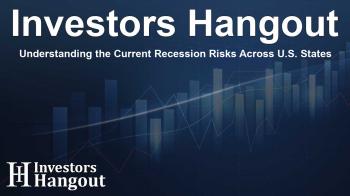Understanding the Current Recession Risks Across U.S. States

Recession Signals Across U.S. States
The U.S. economy is teetering on the brink of a recession, with nearly a third of states experiencing significant challenges, according to the chief economist from Moody's Analytics. His recent analysis revealed that an alarming number of states are either in recession or facing high risk due to various economic pressures.
Moody's Chief Economist Highlights Risky States
Mark Zandi, chief economist at Moody's, noted that 22 states in total, along with the District of Columbia, are categorized as either being in recession or at high risk of entering one. This highlights a concerning trend as economic stability remains elusive for many regions. Additionally, Zandi pointed out that around 13 states are simply treading water, while 16 others are witnessing some level of growth.
Economic Data Analysis and Findings
According to Zandi, the assessment he provided was based on various economic indicators such as employment rates and industrial production metrics. He stressed that these insights are not purely predictive but rather a snapshot of current economic standings. The implications of this data suggest that states closer to the nation's capital are experiencing notable weaknesses, largely due to substantial cuts in federal employment within those areas.
Regional Impacts and Economic Divergence
The broader Washington, D.C. metropolitan area is a key focus, where Zandi indicated that federal workforce reductions have greatly influenced local employment dynamics. Recent statistics showed a loss of over 22,100 federal jobs across the surrounding areas of D.C., Maryland, and Virginia, further accentuating the recessionary pressures impacting this region.
Strengths and Weaknesses in Different States
Interestingly, Zandi pointed out that while Southern states typically showcase stronger economic performance, this growth trend has begun to slow down. On a more positive note, the leading economies of California and New York have remained resilient, serving an essential role in stabilizing the national economy given their substantial contributions to the GDP.
Ongoing Warnings About Economic Risks
Throughout August, Zandi has continued increasing his cautionary messages regarding the impending risks to the economy. He has asserted that various policy decisions—including tariffs and immigration restrictions—are adversely affecting profits, consumer spending, and labor supply. Notably, it was mentioned that consumer spending has plateaued, construction projects are shrinking, and the manufacturing sector is experiencing a downturn.
Identifying Key Indicators of Recession
To better understand the impending risks, Zandi has highlighted several recession watchpoints, focusing on payroll employment rates, the range of job losses, and evolving unemployment scenarios. This is indicative of the labor market's current softness, which could signal deeper economic troubles ahead.
Conclusion
As the situation evolves, it’s critical for policymakers, businesses, and individuals alike to pay close attention to these economic signals. The insights from Mark Zandi and the analysis from Moody's serve as vital touchstones for understanding the broader economic landscape and preparing for potential impacts on both state and national levels.
Frequently Asked Questions
What states are currently at high risk of recession?
According to Moody's analysis, 22 states, including the District of Columbia, are categorized as being in recession or at high risk.
What economic indicators suggest a recession?
Key indicators include employment rates, industrial production, consumer spending levels, and job loss dynamics across various industries.
How are federal workforce cuts affecting the economy?
Federal workforce reductions are notably impacting employment levels, especially in areas near the nation's capital, contributing to recessionary pressures.
What trends are seen in Southern states’ economies?
While Southern states generally demonstrate stronger performance, growth is noted to be slowing recently, presenting potential challenges ahead.
How are California and New York contributing to economic stability?
These two states are considered essential stabilizers for the national economy due to their significant share of GDP, maintaining relative strength despite broader economic concerns.
About The Author
Contact Riley Hayes privately here. Or send an email with ATTN: Riley Hayes as the subject to contact@investorshangout.com.
About Investors Hangout
Investors Hangout is a leading online stock forum for financial discussion and learning, offering a wide range of free tools and resources. It draws in traders of all levels, who exchange market knowledge, investigate trading tactics, and keep an eye on industry developments in real time. Featuring financial articles, stock message boards, quotes, charts, company profiles, and live news updates. Through cooperative learning and a wealth of informational resources, it helps users from novices creating their first portfolios to experts honing their techniques. Join Investors Hangout today: https://investorshangout.com/
The content of this article is based on factual, publicly available information and does not represent legal, financial, or investment advice. Investors Hangout does not offer financial advice, and the author is not a licensed financial advisor. Consult a qualified advisor before making any financial or investment decisions based on this article. This article should not be considered advice to purchase, sell, or hold any securities or other investments. If any of the material provided here is inaccurate, please contact us for corrections.

